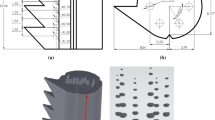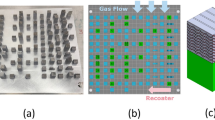Abstract
To control part quality, it is critical to analyze pore generation mechanisms, laying theoretical foundation for future porosity control. Current porosity analysis models use machine setting parameters, such as laser angle and part pose. However, these setting-based models are machine dependent; hence, they often do not transfer to analysis of porosity for a different machine. To address the first problem, a physics-informed, data-driven model (PIM) is used, which instead of directly using machine setting parameters to predict porosity levels of printed parts, first interprets machine settings into physical effects, such as laser energy density and laser radiation pressure. Then, these physical, machine-independent effects are used to predict porosity levels according to “pass,” “flag,” and “fail” categories instead of focusing on quantitative pore size prediction. With six learning methods’ evaluation, PIM proved to achieve good performances with prediction error of 10\(\sim \)26%. Finally, pore-encouraging influence and pore-suppressing influence were analyzed for quality analysis.















Similar content being viewed by others
References
Bi G, Sun CN, Gasser A (2013) Study on influential factors for process monitoring and control in laser aided additive manufacturing. J Mater Process Technol 213:463–468
Mellor S, Hao L, Zhang D (2014) Additive manufacturing: A framework for implementation. Int J Prod Econ 149:194–201
Huang R, Riddle M, Graziano D, et al. (2016) Energy and emissions saving potential of additive manufacturing: the case of lightweight aircraft components. J Clean Prod 135:1559–1570
Benesty J, Chen J, Huang Y, Cohen I (2009) Pearson correlation coefficient. In: Noise reduction in speech processing. Springer, pp 1–4
Frazier WE (2014) Metal additive manufacturing: A review. J Mater Eng Perform 23:1917–1928
Tapia G, Elwany A (2014) A review on process monitoring and control in metal-based additive manufacturing. J Manuf Sci Eng 136
Vilaro T, Colin C, Bartout J -D, et al. (2012) Microstructural and mechanical approaches of the selective laser melting process applied to a nickel-base superalloy. Mater Sci Eng A 534:446–451
Thijs L, Verhaeghe F, Craeghs T, et al. (2010) A study of the microstructural evolution during selective laser melting of Ti–6Al–4V. Acta Mater 58:3303–3312
Wits WW, Carmignato S, Zanini F, Vaneker THJ (2016) Porosity testing methods for the quality assessment of selective laser melted parts. CIRP Ann 65:201–204
Gong H, Rafi K, Gu H, et al. (2015) Influence of defects on mechanical properties of Ti–6Al–4 V components produced by selective laser melting and electron beam melting. Mater Des 86:545–554
Tolochko NK, Mozzharov SE, Yadroitsev IA et al (2004) Balling processes during selective laser treatment of powders. Rapid Prototyp J
Oliveira JP, LaLonde AD, Ma J (2020) Processing parameters in laser powder bed fusion metal additive manufacturing. Mater Des 193:108762
Oliveira JP, Santos TG, Miranda RM (2020) Revisiting fundamental welding concepts to improve additive manufacturing: From theory to practice. Prog Mater Sci 107:100590
Slotwinski JA, Garboczi EJ, Hebenstreit KM (2014) Porosity measurements and analysis for metal additive manufacturing process control. J Res Natl Inst Stand Technol 119:494
Lewis G (2013) Properties of open-cell porous metals and alloys for orthopaedic applications. J Mater Sci Mater Med 24:2293–2325
Vaezi M, Seitz H, Yang S (2013) A review on 3D micro-additive manufacturing technologies. Int J Adv Manuf Technol 67:1721–1754
Song B, Dong S, Zhang B, et al. (2012) Effects of processing parameters on microstructure and mechanical property of selective laser melted Ti6Al4V. Mater Des 35:120–125
Zhang S, Wei Q, Cheng L, et al. (2014) Effects of scan line spacing on pore characteristics and mechanical properties of porous Ti6Al4V implants fabricated by selective laser melting. Mater Des 63:185–193
Xu W, Lui EW, Pateras A, et al. (2017) In situ tailoring microstructure in additively manufactured Ti-6Al-4V for superior mechanical performance. Acta Mater 125:390–400
King W, Anderson AT, Ferencz RM, et al. (2015) Overview of modelling and simulation of metal powder bed fusion process at Lawrence Livermore National Laboratory. Mater Sci Technol 31:957–968
Wu Y -C, San C -H, Chang C -H, et al. (2018) Numerical modeling of melt-pool behavior in selective laser melting with random powder distribution and experimental validation. J Mater Process Technol 254:72–78
Patil N, Pal D, Stucker B (2013) A new finite element solver using numerical eigen modes for fast simulation of additive manufacturing processes. In: Proceedings of the solid freeform fabrication symposium, pp 12–14
Li S, Xiao H, Liu K, et al. (2017) Melt-pool motion, temperature variation and dendritic morphology of Inconel 718 during pulsed-and continuous-wave laser additive manufacturing: A comparative study. Mater Des 119:351–360
Ye J, Khairallah SA, Rubenchik AM, et al. (2019) Energy coupling mechanisms and scaling behavior associated with laser powder bed fusion additive manufacturing. Adv Eng Mater 21:1900185
Gong H, Rafi K, Gu H, et al. (2014) Analysis of defect generation in Ti–6Al–4V parts made using powder bed fusion additive manufacturing processes. Addit Manuf 1:87–98
Khademzadeh S, Carmignato S, Parvin N, et al. (2016) Micro porosity analysis in additive manufactured NiTi parts using micro computed tomography and electron microscopy. Mater Des 90:745–752
Aboulkhair NT, Everitt NM, Ashcroft I, Tuck C (2014) Reducing porosity in AlSi10Mg parts processed by selective laser melting. Addit Manuf 1:77–86
Johnson NS, Vulimiri PS, To AC et al (2020) Machine learning for materials developments in metals additive manufacturing. arXiv:200505235
Gobert C, Reutzel EW, Petrich J, et al. (2018) Application of supervised machine learning for defect detection during metallic powder bed fusion additive manufacturing using high resolution imaging. Addit Manuf 21:517–528
Zhang W, Mehta A, Desai PS, Higgs C (2017) Machine learning enabled powder spreading process map for metal additive manufacturing (AM)
Scime L, Beuth J (2019) Using machine learning to identify in-situ melt pool signatures indicative of flaw formation in a laser powder bed fusion additive manufacturing process. Addit Manuf 25:151–165
Donegan SP, Schwalbach EJ, Groeber MA (2020) Zoning additive manufacturing process histories using unsupervised machine learning. Mater Charact 161:110123
Wang C, Tan XP, Tor SB, Lim CS (2020) Machine learning in additive manufacturing: State-of-the-art and perspectives. Addit Manuf 101538
Kappes B, Moorthy S, Drake D, et al. (2018) Machine learning to optimize additive manufacturing parameters for laser powder bed fusion of Inconel 718. In: Proceedings of the 9th international symposium on superalloy 718 & Derivatives: Energy, aerospace, and industrial applications. Springer, pp 595–610
Liu S, Stebner AP, Kappes BB, Zhang X (2020) Machine learning for knowledge transfer across multiple metals additive manufacturing printers. arXiv e-prints
Tapia G, Elwany AH, Sang H (2016) Prediction of porosity in metal-based additive manufacturing using spatial Gaussian process models. Addit Manuf 12:282–290
Kamath C, El-Dasher B, Gallegos GF, et al. (2014) Density of additively-manufactured, 316L SS parts using laser powder-bed fusion at powers up to 400 W. Int J Adv Manuf Technol 74:65– 78
Garg A, Lam JSL, Savalani MM (2015) A new computational intelligence approach in formulation of functional relationship of open porosity of the additive manufacturing process. Int J Adv Manuf Technol 80:555–565
Shamsaei N, Yadollahi A, Bian L, Thompson SM (2015) An overview of direct laser deposition for additive manufacturing; Part II: Mechanical behavior, process parameter optimization and control. Addit Manuf 8:12–35
Liu S, Kappes BB, Amin-ahmadi B, et al. (2020) A physics-informed feature engineering approach to use machine learning with limited amounts of data for alloy design: Shape memory alloy demonstration. arXiv:200301878
Sangid MD (2020) Coupling in situ experiments and modeling–Opportunities for data fusion, machine learning, and discovery of emergent behavior. Curr Opin Solid State Mater Sci 24:100797
Wang Z, Liu P, Ji Y, et al. (2019) Uncertainty quantification in metallic additive manufacturing through physics-informed data-driven modeling. JOM 71:2625–2634
Yan W, Lin S, Kafka OL, et al. (2018) Data-driven multi-scale multi-physics models to derive process–structure–property relationships for additive manufacturing. Comput Mech 61:521–541
Zhu Q, Liu Z, Yan J (2020) Machine learning for metal additive manufacturing: Predicting temperature and melt pool fluid dynamics using physics-informed neural networks. arXiv:200813547
Ren F, Ward L, Williams T et al (2018) Accelerated discovery of metallic glasses through iteration of machine learning and high-throughput experiments. Sci Adv 4:eaaq1566
Ward L, Agrawal A, Choudhary A, Wolverton C (2016) A general-purpose machine learning framework for predicting properties of inorganic materials. npj Comput Mater 2:16028
Ghiringhelli LM, Vybiral J, Levchenko SV, et al. (2015) Big data of materials science: critical role of the descriptor. Phys Rev Lett 114:105503
Stanev V, Oses C, Kusne AG, et al. (2018) Machine learning modeling of superconducting critical temperature. npj Comput Mater 4:1–14
Geerlings H (2018) TRACR: a software pipeline for high-throughput materials image analysis–an additive manufacturing study
Balachandran PV, Xue D, Theiler J, et al. (2016) Adaptive strategies for materials design using uncertainties. Sci Rep 6:19660
Williams CKI, Rasmussen CE (1996) Gaussian processes for regression. In: Advances in neural information processing systems, pp 514–520
Bishop CM (2006) Pattern recognition and machine learning. Springer
Cawley GC, Talbot NLC (2003) Efficient leave-one-out cross-validation of kernel fisher discriminant classifiers. Pattern Recognit 36:2585–2592
Acknowledgements
Thanks for valuable suggestions and experiment assistance from Dr. Aaron Stebner, Dr. Branden B. Kappes, Mr. Henry Geerlings, and Mr. Senthamilaruvi Moorthy.
Author information
Authors and Affiliations
Contributions
Rui proposed the method, did the experiment, and analyzed the results. Sen analyzed the result. Xiaoli managed the whole project.
Corresponding author
Ethics declarations
Consent for publication
Yes, agreed by all authors.
Conflict of interest
The authors have no competing interest.
Additional information
Publisher’s note
Springer Nature remains neutral with regard to jurisdictional claims in published maps and institutional affiliations.
Electronic supplementary material
Below is the link to the electronic supplementary material.
Rights and permissions
About this article
Cite this article
Liu, R., Liu, S. & Zhang, X. A physics-informed machine learning model for porosity analysis in laser powder bed fusion additive manufacturing. Int J Adv Manuf Technol 113, 1943–1958 (2021). https://doi.org/10.1007/s00170-021-06640-3
Received:
Accepted:
Published:
Issue Date:
DOI: https://doi.org/10.1007/s00170-021-06640-3




